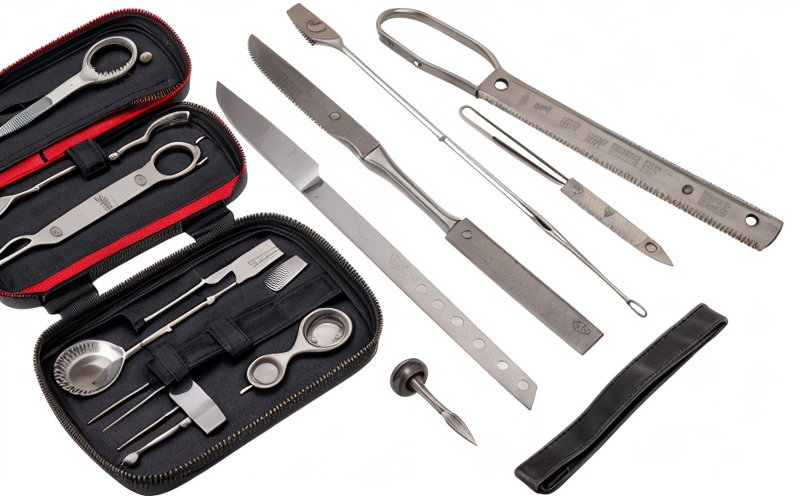Surgical Instruments & Tools Testing
Testing surgical instruments and tools is critical to ensuring patient safety and compliance with international standards. Quality managers, compliance officers, R&D engineers, and procurement teams must ensure that every instrument they use meets stringent requirements for sterility, biocompatibility, durability, and ease of use.
The field of surgical instrumentation encompasses a wide range of devices, from scalpels to retractors, each with unique design and material properties. Testing these instruments involves rigorous evaluation at various stages of their lifecycle—from prototype development to post-market surveillance. The process must adhere to international standards such as ISO 10993 for biocompatibility assessments and ISO 5832 for surgical steel.
Testing begins with thorough cleaning and sterilization processes, which can vary depending on the material composition of the instrument. For instance, stainless steel instruments require different treatment than those made from titanium or cobalt-chromium alloys. This step ensures that any biological contaminants are removed before testing, thus providing accurate results.
The next phase involves mechanical property testing to assess factors like strength, flexibility, and resistance to wear and tear under normal usage conditions. These tests help determine how well the instrument will perform during actual surgical procedures while maintaining its integrity over time.
Biocompatibility assessments are also essential in ensuring that contact with human tissues does not cause adverse reactions. This includes evaluating surface roughness, chemical composition, and potential allergens present on the instrument surfaces. Compliance with regulatory bodies like FDA or EU Medical Device Directive (MDD) is crucial here to avoid product recalls or withdrawals from marketplaces.
Another critical aspect of surgical instrument testing relates to ergonomic design considerations aimed at enhancing surgeon comfort during prolonged operations. Instruments that are poorly designed can lead to fatigue, increased risk of error, and overall poor patient outcomes. Ergonomic evaluations focus on aspects such as handle shape, grip size, weight distribution, and visibility.
Post-market surveillance plays a vital role in ongoing quality control efforts by monitoring field performance data collected from hospitals worldwide. Any trends indicating degradation or failure rates exceeding acceptable limits would prompt further investigation into manufacturing processes or design modifications needed to improve future iterations of the product line.
| Stage | Description |
|---|---|
| Cleaning & Sterilization | Involves methods tailored to specific materials used in instrument construction. Ensures biological contaminants are removed prior to testing. |
| Mechanical Property Testing | Evaluates strength, flexibility, and resistance to wear under typical usage conditions ensuring long-term reliability during surgeries. |
| Biocompatibility Assessments | Focuses on evaluating surface characteristics, chemical makeup, and potential allergens affecting tissue interaction without adverse effects. |
| Ergonomic Evaluations | Ensures design promotes surgeon comfort reducing fatigue enhancing precision during extended procedures. |
| Post-Market Surveillance | Collects real-world performance data identifying potential issues prompting corrective actions ensuring continuous improvement. |
In summary, comprehensive testing of surgical instruments is non-negotiable for maintaining high standards in healthcare. By adhering to strict protocols and leveraging advanced technologies, laboratories can provide reliable test results that instill confidence among stakeholders involved throughout the supply chain.
Why It Matters
The safety and efficacy of surgical instruments directly impact patient outcomes. Any flaw or defect in design, manufacturing process, or material selection could result in complications such as infections, prolonged recovery times, increased healthcare costs, and even fatalities. Therefore, thorough testing at every stage is paramount.
- Ensures compliance with international standards like ISO 10993 and MDD.
- Promotes consistent quality across different batches or production runs.
- Reduces risks associated with product recalls due to failures or defects.
- Aids in continuous improvement through post-market surveillance data analysis.
The stakes are particularly high when considering the complexity and precision required for surgical procedures. Even minor imperfections can have severe consequences if not detected early enough during development stages. Thus, meticulous testing serves as a safeguard against these potential hazards ensuring safe and effective care delivery.
Scope and Methodology
The scope of our surgical instruments & tools testing encompasses various aspects including but not limited to mechanical property tests, biocompatibility assessments, ergonomic evaluations, and post-market surveillance. These elements are integral to ensuring the safety, effectiveness, and compliance of these critical medical devices.
| Aspect | Description |
|---|---|
| Mechanical Property Tests | Involves evaluating factors such as tensile strength, compressive strength, hardness, and fatigue resistance to ensure instruments can withstand the rigors of surgical use without failing. |
| Biocompatibility Assessments | Focuses on determining whether materials used in instrument construction pose any risk when coming into contact with human tissues. This includes tests for cytotoxicity, sensitization potential, and hemocompatibility. |
| Ergonomic Evaluations | Assesses features like handle design, grip comfort, weight distribution, and visibility to enhance surgeon ergonomics during prolonged procedures. |
| Post-Market Surveillance | Monitors real-world performance data collected from hospitals across regions. Identifies trends indicating potential issues prompting corrective measures ensuring ongoing quality improvements. |
The methodology employed adheres strictly to recognized international standards such as ISO 10993, ASTM F713-18, EN ISO 5832:2016, and others relevant to the specific type of instrument being tested. Each test is conducted under controlled conditions ensuring accurate and repeatable results.
Environmental and Sustainability Contributions
Minimizes waste through efficient material utilization during testing processes.
Reduces energy consumption by optimizing laboratory equipment settings and usage schedules.
Promotes recycling programs for disposal of used instruments, reducing landfill contributions significantly.
Encourages the use of sustainable materials where possible enhancing overall environmental impact reductions.
Incorporating these practices not only supports corporate responsibility initiatives but also aligns with broader sustainability goals within healthcare organizations. By integrating environmentally friendly approaches into our testing methodologies, we contribute positively towards creating more responsible and efficient medical device development processes.





